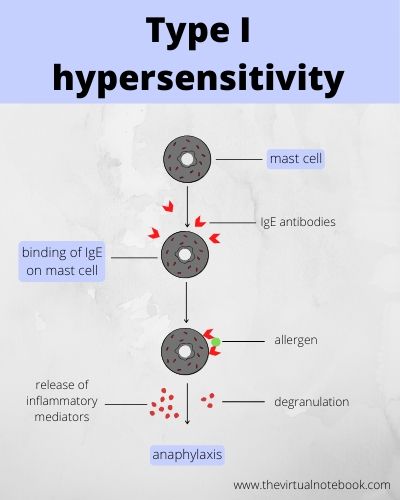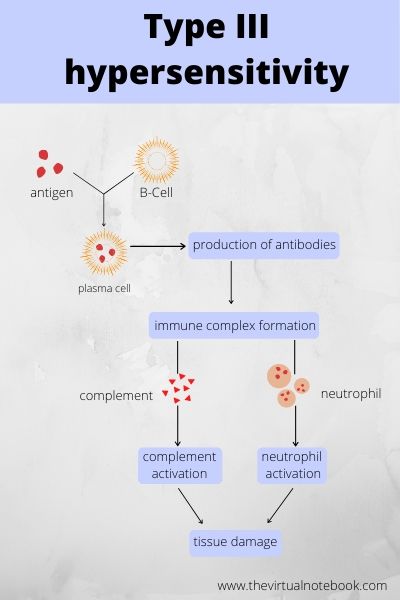Type 2 Hypersensitivity Adcc Receptor Three Mechanisms Review
Hypersensitivity refers to farthermost physical sensitivity to particular substances or weather condition. It is the undesirable reactions produce by the normal immune system in the grade of allergies and autoimmunity. In other words, information technology is an over-reaction of the allowed system and these reactions may be damaging, uncomfortable, or occasionally fatal. Y'all can divide hypersensitivity into 5 types on the ground of their mechanism and of course, the time taken for the reaction.
- type I hypersensitivity,
- type II hypersensitivity,
- so, type III hypersensitivity,
- blazon IV hypersensitivity
- and lastly, blazon V hypersensitivity.
Types I, 2, and III are antibody-mediated (immediate) hypersensitivity, while type Iv is jail cell-mediated (delayed) hypersensitivity reactions.
TYPE I HYPERSENSITIVITY
Type I hypersensitivity reaction is normally called an allergic or immediate hypersensitivity reaction. This reaction is ever rapid and tin occur within minutes of exposure to an antigen. Type I hypersensitivity reactions are initiated by the interactions between an IgE antibiotic and a multivalent antigen.
(IgE antibodies are course of antibodies that produces in allergic reactions and multivalent antigen is an antigen molecule with more than one identical epitope per molecule)
Blazon I hypersensitive reactions tin induce by a special type of antigen refer to as allergens which take all the hallmarks of the
Mutual allergens for type I hypersensitivity are plant pollen, foods (basics, eggs, seafood, etc.), certain drugs (penicillin, Salicylates, local anaesthetics, dust mites, etc.
Type I reaction tin can occur in ii forms:
- anaphylaxis, and
- atopy.
The precise component of why some people are more prone to Type 1 hypersensitivity is unclear. Notwithstanding, it has been shown that such individuals preferentially produce more lymphocytes or TH2 cells which in turn favor the change of grade
1. Anaphylaxis
It is an acute and potentially fatal immediate hypersensitivity reaction. The fourth dimension of onset of symptoms depends on the level of hypersensitivity and the site of exposure to the antigen. More often than not, information technology affects skin, respiratory tract and cardiovascular arrangement. Plasma prison cell secretes IgE in response to allergen-specific TH4 cells. This class of antibody binds with high affinity to Fc receptor on the surface of tissue mast cells and basophils. Binding of IgE to the mast cells is besides known as sensitization. IgE-coated mast cells can actuate on echo antigen encounter. The primary cellular component in this hypersensitivity are the mast cell, eosinophils, and basophil.

Further. anaphylaxis has two phases:
- firsthand
- late
Immediate phase
This stage is characterized past degranulation and release of pharmacologically active mediators inside minutes of re-exposure to the same antigen. Histamine is the principal biogenic amine that causes rapid vascular and smooth muscle reactions.
Late stage
This stage begins to develop 4–six hours after the immediate stage reaction and can persist for ane–ii days. It is identified by the infiltration of neutrophils, macrophages, eosinophils, and lymphocytes to the site of reaction.
2. Atopy
Unlike anaphylaxis, atopy is periodic and nonfatal immediate hypersensitivity reaction. Atopic individuals produce loftier levels of IgE in response to allergens as compared to normal individuals who do non. An case of atopic reactions is bronchial asthma. Atopic hypersensitivity does not transfer through lymphoid cells but information technology can transfer past serum.
Symptoms
Some of the common symptoms are skin rashes, tingling around the mouth, diarrhoea, etc., Information technology can touch on diverse organs of the body including skin (Urticaria and Eczema), eyes (conjunctivitis) and olfactory organ (rhinorrhea.
Time
Generally, information technology took 10-30 minutes for the symptoms to appear and occasionally it may accept up to ten-12 hours.
Diagnosis
Its diagnosis may include skin tests like puncture and intradermal. In addition, measurement of total IgE and IgE antibodies, specific against suspected allergens, too performed.
Treatment
Antihistamines are used for the treatment of blazon I hypersensitivity. These medications block histamine receptors on cell membrane surfaces.
Treatment for anaphylactic symptoms is injection with epinephrine, a stiff neurotransmitter and hormone that finer halts the immune response.
IgG blockers are likewise used to treat type I hypersensitivity.
TYPE II HYPERSENSITIVITY
Type Two hypersensitivity is also known every bit cytotoxic hypersensitivity or antibiotic-mediated hypersensitivity reactions. Also, information technology may affect a multifariousness of organs and tissues. Type Ii hypersensitivity reactions involve antibiotic-mediated destruction of cells by immunoglobulins of heavy chain classes other than IgE.
Further, see: Immunoglobulin classes and construction
Antibody jump to a cell-surface antigen can induce death of the antibody-spring jail cell by 3 distinct mechanisms.
- First, the antibiotic bound to a cell surface can activate the complement system, creating pores in the membrane of a foreign jail cell.
- Secondly, antibodies can mediate cell devastation past the antibody-dependent cell-mediated cytotoxicity (ADCC). In this process, cytotoxic cells with Fc receptors bind to the Fc region of antibodies on target cells and promote killing of the cells.
- Finally, the
antibody bound to a foreign cell tooserve as an opsonin, enabling phagocytic cells with Fc or C3b receptors to bind and phagocytose the antibiotic-coated cell
Examples
- Claret transfusion/transfusion reactions: When transfusion with mismatch blood occurs, a transfusion reaction takes place due to the devastation of the donor RBCs through the iso-hemagglutinins against the foreign antigen.
- Erythroblastosis Fetalis: information technology develops when maternal antibodies specific for fetal claret group antigens cross the placenta and destroy fetal RBCs. As a result, severe hemolysis occurs, leading to anaemia and hyperbilirubinemia, which tin fifty-fifty be fatal.
- Drug-Induced Hemolysis: Certain drugs (such every bit penicillin, quinidine, phenacetin, etc.) may induce hemolysis of cherry blood cells. They attach to the surface of red blood cells and induce the germination of IgG antibodies. These autoantibodies then react with red claret prison cell surface, causing hemolysis.
Symptoms
Redness and swelling are major symptoms under this categories. Generally, it develops from any where between minutes to hours.
Treatment
The treatment includes anti-inflammatory and immunosuppressive agents.
Type Three HYPERSENSITIVITY (immune-complex)
Type Iii reactions are results of antigen-antibody allowed complexes, which induce an inflammatory reaction in tissues. The Reaction betwixt the various antigens and antibodies in the body gives ascension to the formation of immune complexes. In the normal condition, the mononuclear-phagocyte system removes these allowed complexes through the participation of RBC.

In sure cases, these allowed complexes are beyond the accomplish of phagocytic clearance capacity. As a event, they tin increase and cause disease.
Immune circuitous deposition happens at:
- on blood vessel walls
- in the synovial membrane of joints
- on the glomerular basement membrane of the kidneys
- on the choroid plexus of the encephalon
- sometimes, allowed complexes form at the site of inflammation itself
Immune complexes fix and actuate the complement system. Complement fixation results in the product of the anaphylatoxin chemokines C3a and C5a that stimulate the
Examples
- Arthus reaction
- Serum sickness
Symptoms
Every bit a result of type Three hypersensitivity, complex deposition in the tissues tin can requite ascension to symptoms such as fever, rashes, joint pain, lymph node enlargement, and protein in the urine.
Time
Mostly, it requires 3-x hours for the symptoms to occur.
Treatment
The treatment includes anti-inflammatory agents. In addition, Immunosuppressive drugs such as methotrexate and cyclosporin are also used in some cases.
TYPE IV HYPERSENSITIVITY
you can besides call it delayed-blazon cell-mediated hypersensitivity reactions. It starts hours or days after main contact with the antigen and often lasts for days. At that place is a large influx in non-specific inflammatory cells, in detail, macrophages in this reaction. It differs from the other types of hypersensitivity because it mediates through cell-mediated immunity. This reaction occurs due to the activation of specifically sensitized T lymphocytes rather than antibodies.
In 1890, Robert Koch observed this type of hypersensitivity in tuberculosis every bit a localized reaction. Information technology is besides known as the tuberculin reaction. Afterwards, on the realization that the reaction can be induced in diverse pathologic conditions, it was renamed as delayed–blazon hypersensitivity.
DTH (Delayed-Type Hypersensitivity) response begins with an initial sensitization by antigen, followed past a period of at least i to ii weeks. During this phase, antigen-specific T cells actuate and clonally expand. TH1 subtypes CD4 cells activate during the sensitization phase.
DTH reactions are of two types:
- contact hypersensitivity and
- tuberculin-type hypersensitivity reactions
1. Contact hypersensitivity
Contact hypersensitivity is a type IV hypersensitivity. Information technology occurs subsequently sensitization with sure substances. For example, certain drugs similar sulfonamides and neomycin, a component of a cosmetic or a pilus dye, a metal ion such as nickel, soaps and other substances.
This reaction occurs when these substances enter the skin and combine with body proteins to become consummate antigens to which a person becomes sensitized. On second exposure to the same antigen, the immune system responds past an set on of cytotoxic T cells that cause impairment, generally in the skin.
The status shows equally itching, erythema, vesicle, eczema, or necrosis of peel within 12–48 hours of the second exposure. Now the best way to avert a DTH response to avert the causative antigen. Afterwards the development of hypersensitivity, topical or oral corticosteroids used to suppress the destructive immune response.
ii. Tuberculin-type hypersensitivity reaction
Tuberculin reaction is a typical example of delayed hypersensitivity.
Tuberculin skin exam determines whether an individual has been exposed previously to Mycobacterium tuberculosis or not. In this exam, a minor amount of tuberculin protein is injected intradermally. If skin, at the site of injection, develop red, slightly swollen, firm lesion after 48–72 hours, it indicates a positive test.
Various other pare tests are there to detect DTH. These include many skin tests in bacterial, fungal, viral, and helminthic infections.
Symptoms
Symptoms include redness and hardness associated with pain.
Diagnosis
In Vivo, Diagnostic tests contain delayed cutaneous resistance. For example, the Montoux test and the patch test. Moreover, the tests or biopsy for delayed hypersensitivity include mitogenic responses.

Blazon V HYPERSENSITIVITY (Stimulatory Type)
Antibodies combine with antigens on the cell surface, which induces cells to proliferate and differentiate and enhances the activity of effector cells. Type Five hypersensitivity reaction plays an important role in the pathogenesis of Graves' disease, in which thyroid hormones are produced in excess quantity. Further, long-acting thyroid-stimulating antibody combines with thyroid-stimulating hormone (TSH) receptors on a thyroid prison cell surface. Interaction with TSH receptor produces an effect like to the TSH, resulting in excess product and secretion of thyroid hormone, which is responsible for Graves' disease.
REFERENCES
Textbook of microbiology and immunology by Subhash Chanda Parija, page no. 149-155.
Also, Kuby immunology, 7th edition, chapter no. fifteen
www.microbiologybook.org/ghaffar/hyper00.htm
https://scopeheal.com/hypersensitivity/
Source: https://www.thevirtualnotebook.com/hypersensitivity-types-symptoms-treatment/
0 Response to "Type 2 Hypersensitivity Adcc Receptor Three Mechanisms Review"
Post a Comment